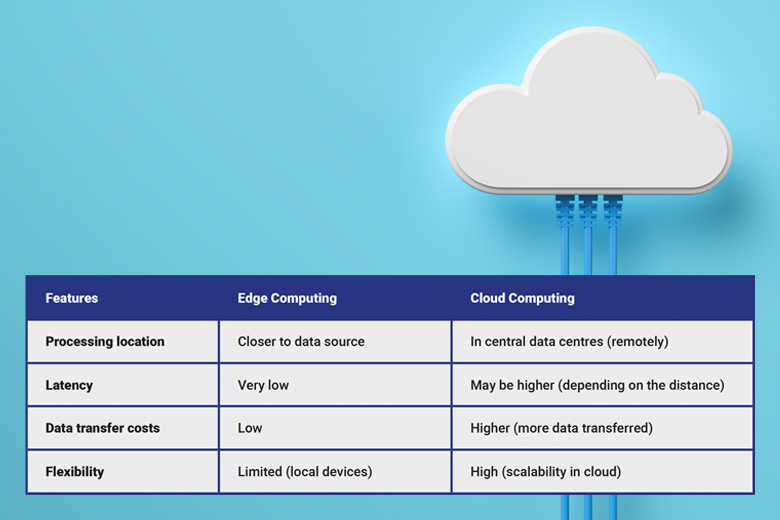In an era of rapidly evolving information technology, decisions regarding IT infrastructure are becoming increasingly crucial for companies and organisations. Among popular data processing models, two approaches are dominating: Edge Computing and Cloud Computing. Each offers different advantages and finds its use in various scenarios. This article takes a closer look at both those technologies, their benefits, disadvantages, and practical use cases to help you make an informed decision.
Cloud Computing – what it is and how does it work?
Cloud Computing is a model in which data and applications are stored and processed on the servers of a cloud service provider. Users may access them via Internet at any time and from any place. Popular platforms, such as Amazon Web Services (AWS), Microsoft Azure or Google Cloud Platform, offer diverse services – from data storage to advanced analysis and artificial intelligence.
We can categorise the CC services available on the IT market into three types: IaaS (Infrastructure as a Service) – access to a basic infrastructure such as servers, networks, and mass storage (e.g., AWS EC2, Microsoft Azure), PaaS (Platform as a Service) – platforms used to create, test, and implement applications (e.g., Google App Engine, Heroku), and SaaS (Software as a Service) – ready-to-use applications available via a browser, e.g., Gmail, Dropbox, Microsoft 365.
Advantages of Cloud Computing
- Flexibility and scalability – cloud processing allows adjusting resources to the company’s current needs. As the demand grows or drops, you may easily decrease or increase the magnitude of used resources.
- Lower initial costs – there is no need to invest in expensive hardware or infrastructure. The user pays for used resources according to the pay-as-you-go model.
- Safety and backups – the leading cloud service providers invest significant amounts in security measures and data protection, which reduces the risk of data loss.
- Access from any place – applications and data are accessible to users worldwide, enabling efficient collaboration between teams.
Disadvantages of Cloud Computing
- Dependence on the Internet connection – the efficiency of applications depends on the speed and stability of the Internet connection.
- Delays – transferring data to remote data centres may cause delays, which is critical in the case of real-time applications.
- Lack of full control – data is stored on external servers, which may raise concerns regarding privacy and regulatory compliance.
Edge Computing – what it is and how does it work?
Edge Computing is a model in which data are processed locally, near the place where they are generated. This may be, e.g., an IoT (Internet of Things) device, router or a dedicated edge server. The concept of Edge Computing is to minimise the need to transfer data to a central data centre, which speeds up processes and reduces network load.
Advantages of Edge Computing
- Low latency – processing data close to their source eliminates delays caused by transferring them to remote data centres.
- Lower use of the bandwidth – only processed and relevant data are transferred further, which reduces network load.
- Increased safety – processing data locally reduces the risk of data interception during transfer.
- Independence – Edge Computing systems can operate without Internet access, which is crucial in areas with limited network connectivity.
Disadvantages of Edge Computing
- Higher initial costs – it requires investment in local infrastructure and devices.
- Scalability – expanding the system may be more complicated and costly compared to using cloud services.
- Management – the necessity to monitor and maintain many local devices may pose a challenge.
Edge Computing vs. Cloud Computing? When to choose the right solution?
Both approaches have a place in today’s technological landscape. The choice depends on specific needs of an organisation and the nature of its operations.

When to choose Cloud Computing?
- Start-ups and small companies – Cloud Computing enables a quick start with low initial costs, offering flexibility and scalability.
- Storing a large amount of data – cloud is perfect for long-term storage of data such as backups or archives.
- Applications with global reach – companies that need to access data from various locations can take advantage of a global cloud infrastructure.
When to choose Edge Computing?
- Real-time applications – in the case of systems that require quick response, such as autonomous vehicles or industrial IoT, Edge Computing offers low latency.
- Areas with limited Internet access – local data processing allows operations to continue even with a slow network connection.
- High level of privacy – in the case of companies that process sensitive data, Edge Computing reduces the risk associated with transfer of the data.
Hybrid approach as a compromise
Many companies choose a hybrid solution that combines Cloud Computing and Edge Computing. Critical data are processed locally, while less significant information is sent to the cloud. This optimises costs, performance, and safety.
Summary
The choice between Edge Computing and Cloud Computing depends on specific project requirements and the company’s priorities. Cloud Computing is most useful for applications that require scalability and global reach, while Edge Computing is optimal for real-time applications and local data processing. The increasingly popular hybrid approach allows leveraging the advantages of both worlds, offering flexible and efficient data management.